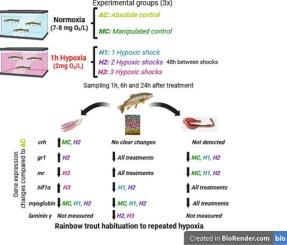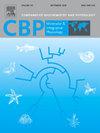Response of rainbow trout mucosal tissues under repeated hypoxia episodes
IF 2.2
3区 生物学
Q4 BIOCHEMISTRY & MOLECULAR BIOLOGY
Comparative Biochemistry and Physiology A-Molecular & Integrative Physiology
Pub Date : 2025-09-20
DOI:10.1016/j.cbpa.2025.111931
引用次数: 0
Abstract
Hypoxic events are common in both natural and aquaculture environments due to external factors or anthropogenic activities. To cope with this fluctuating environment, fish activate complex systemic stress responses, but less is known about their mucosal responses. To investigate this, five experimental groups were established: absolute control (AC), manipulated control (MC), and three groups exposed to a single hypoxic shock (H1) or repeated hypoxic shocks (H2 and H3), sampled at 1, 6, and 24 h after hypoxia. Mucus cortisol levels increased 1 h after manipulation and hypoxic shocks, confirming that the stress response was activated. However, cortisol levels decreased as the fish underwent more shocks. A significant up-regulation of the crh gene by treatment was observed in the gills, while no expression was detected in the intestine. Additionally, an up-regulation of gr1 and mr gene expression was found in the gills, whereas the skin and intestine showed an opposite response, with gene expression returning to control levels after the third hypoxic shock (H3). Hif-1α and myoglobin gene expression showed clear tissue-specific regulation, likely related to their primary functions. In the skin and intestine, as hif-1α levels increased, myoglobin expression decreased, while in the gills, the opposite pattern was observed, with higher myoglobin expression during the reoxygenation phase. Overall, the results suggest that repeated hypoxia promotes tolerance and a certain degree of habituation in rainbow trout, without compromising their survival.

虹鳟鱼黏膜组织对反复缺氧发作的反应。
由于外部因素或人为活动,缺氧事件在自然和水产养殖环境中都很常见。为了应对这种波动的环境,鱼类激活了复杂的全身应激反应,但对它们的粘膜反应知之甚少。为了研究这一点,我们建立了五个实验组:绝对对照组(AC)、操纵对照组(MC)和三个暴露于单次缺氧休克(H1)或重复缺氧休克(H2和H3)的组,分别在缺氧后1、6和24 h取样。操作和缺氧休克后,粘液皮质醇水平升高1 h,证实应激反应被激活。然而,皮质醇水平随着鱼受到更多电击而下降。经处理,crh基因在鳃中显著上调,而在肠道中未检测到表达。此外,在鳃中发现gr1和mr基因表达上调,而皮肤和肠道则表现出相反的反应,在第三次缺氧休克(H3)后基因表达恢复到控制水平。hif -1α和肌红蛋白基因表达表现出明显的组织特异性调控,可能与其主要功能有关。在皮肤和肠道中,随着hif-1α水平的升高,肌红蛋白的表达降低,而在鳃中,观察到相反的模式,在再氧化阶段肌红蛋白的表达较高。总的来说,结果表明,反复缺氧可以促进虹鳟鱼的耐受性和一定程度的适应,而不会影响它们的生存。
本文章由计算机程序翻译,如有差异,请以英文原文为准。
求助全文
约1分钟内获得全文
求助全文
来源期刊
CiteScore
5.00
自引率
4.30%
发文量
155
审稿时长
3 months
期刊介绍:
Part A: Molecular & Integrative Physiology of Comparative Biochemistry and Physiology. This journal covers molecular, cellular, integrative, and ecological physiology. Topics include bioenergetics, circulation, development, excretion, ion regulation, endocrinology, neurobiology, nutrition, respiration, and thermal biology. Study on regulatory mechanisms at any level of organization such as signal transduction and cellular interaction and control of behavior are also published.

 求助内容:
求助内容: 应助结果提醒方式:
应助结果提醒方式:


